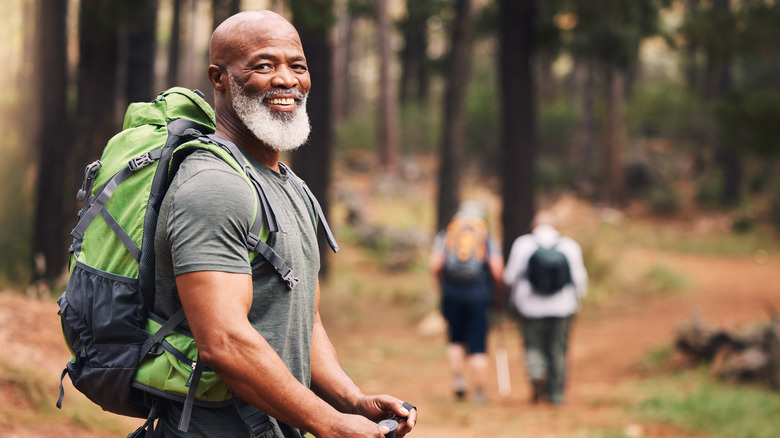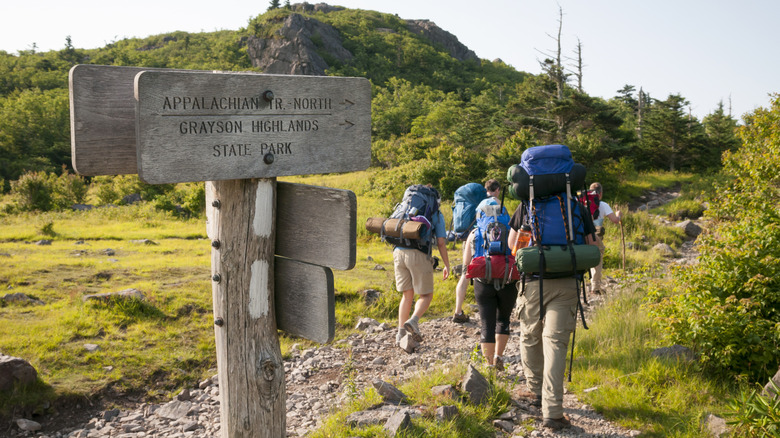The Intricate Rules And Rituals Of Getting Your Own Backpacker 'Trail Name'
Appalachian Trail Through-hiker Tara Dower set a world record when she finished the 2,190-mile hike on September 21, 2024, breaking the record for fastest completion, at 40 days, 18 hours, and 5 minutes, winning praise around the world. But many of the hikers she passed on the AT didn't know her as "Tara Dower," but rather as Candy Mama, her "trail name."
Trail names are among the great AT traditions. The Appalachian Trail Conservancy reports that more than 3 million people walk part of this epic route each year, and 3,000 of those will attempt to thru-hike the entire thing, from Georgia to Maine. In such an ever-moving community, trail names help people shed their everyday identities. These names come in all forms, from the poetic and noble to the wisecracking and ridiculous. Some of the most popular examples, according to Halfway Anywhere, are "Doc," "Sunshine," "Strider," and "Scout," while more creative entries include "Smurf," "Headbanger," and "Tiny Dancer." Many describe a personality trait or incident; others are just risqué puns. A trail name can be pretty much anything, and just about any hiker can adopt one.
How do you get a trail name? These aren't official pseudonyms, and they're certainly not required. Nor are trail names limited to the AT; you can use one on the Pacific Crest Trail, the Continental Divide Trail, or anywhere else, really. But most trail names follow a particular pattern, informal rules that true cross-country veterans try to stick to. Preparing for the Appalachian Trail takes time, effort, and investment; but once you start your journey, a trail name may simply emerge, ready for the taking.
How to build a new identity on the Appalachian Trail
Most hikers agree that it's improper to give yourself a trail name. Nearly all trail names are given to you by others, and they're usually improvised, inspired by casual conversation or observed behavior. Maybe something happens — a twisted ankle, a rare bird flying overhead — that prompts a new nickname. Once a trail name is proposed, you don't have to accept it; you may have accidentally slid down a wet hill, and maybe "Slippy McMudbum" sounded funny at the time, but you don't have to bear this trail name for thousands of miles. Maybe you find yourself poking at a campfire, and someone calls you "Sparky Loggs." Or maybe you'll be "Bamaman," or "Bilko," or "The Wild Turkey," like well-known AT hikers before you. Hikers praise originality, but there's no trademark on trail names.
Long-distance hikers soon learn that the AT is a complex grapevine of news and stories, and distinctive trail names help people keep track of each other down the line. Many AT hikers have cultivated the concept of "tramily," people who walk alongside you or share campsites and become intimately familiar with your alter-ego. Far from permanent residences and professional ambitions, a tramily knows you in a particular way — as an athlete, adventurer, and appreciator of the AT — and a trail name distinguishes this persona from the one who pays a mortgage and needs to get the car inspected. It's just one of the many things first-timers learn in the first few weeks of thru-hiking.
Trail names: a well-worn tradition
The trail-naming tradition goes back to at least 1948 when Earl Shaffer became the first documented thru-hiker to complete the AT. No one had really conceived of doing such a thing before, so it's fitting that Shaffer would be known as "The Crazy One." Before the AT, "hobo names" were popular among itinerant workers in the 1930s, and hiking culture bears a striking resemblance to other nickname-heavy subcultures — carnies, surfers, bikers, and so on.
While trail names are mostly good fun, they do have some practical value when folks are missing or have lost track of each other. More and more hikers maintain social media accounts, which has changed travel in many ways. Trail names can double as hashtags and handles; smartphone-carrying trekkers can easily catch up with each others' adventures on TikTok and Instagram. That said, there are significant downsides to this trend as well, and many hikers consider their trail names too personal to post online.
The best advice is not to force a trail name; this is a social, organic experience, and when the right one comes, you'll know it. Some hikers never decide on a trail name, and that's okay, too. Finally: You don't have to have a trail name yourself to bestow one on someone else. When you come up with something clever and fitting, you may give a gift that lasts a lifetime. Just ask Slippy McMudbum.


